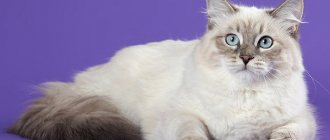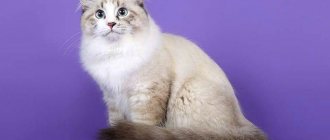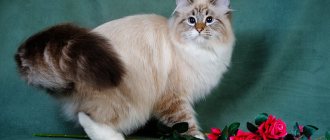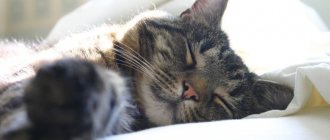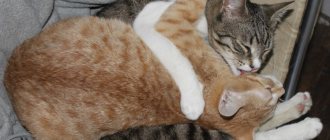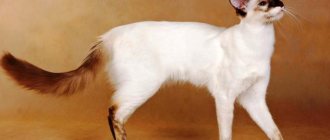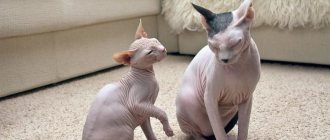Origin story
Neva Longhair is a very young breed. Breeding of these cute cats with an unusual color and affectionate character began in the 80s of the 20th century, but to this day some felinological organizations stubbornly refuse to recognize the Neva Masquerade as a separate breed. The fact is that once upon a time “Neva masquerade” was the name given to the type of color of Siberian cats, and only quite recently they decided to separate them into an independent group with its own standard and characteristics.
Their ancestors are Siberian, Persian and Siamese cats. In 1988, the famous breeder Olga Mironova brought a guest to the exhibition - a cat with an unusual pattern on her face. The judges appreciated the rare beauty.
A few years later - in 1992 - a standard was drawn up and a name was given to the new breed: Neva Masquerade (abbreviated as Nevak).
Moscow felinologists continued work on breeding the new breed. A dozen new colors have appeared, Neva Masquerade cats have become regular participants in international exhibitions and shows.
This breed is a real gem. And it's not just about external grace. Neva Masquerade cats can be kept by allergy sufferers who dream of having a pet. Neva cats have practically no antigens in their saliva; therefore, nothing gets on their fur when licked.
Myths about Nevaks
Myth one
The first and, perhaps, the most unpleasant myth for potential owners of Nevaka is about hypoallergenicity. Our cat is a strong allergen
.
A small contact of a person with an allergy with it is enough, symptoms immediately appear - redness of the eyes, tearing, runny nose, sneezing. In addition, during the heating season, when the apartments are very dry, Nevaks constantly shed, their luxurious undercoat is literally everywhere. If you like to cuddle with a cat, then the undercoat instantly gets into your nose - the result, again, is sneezing. Please, if you decide to get a kitten, spend another hour with him at the breeder, check yourself for allergies. The hypoallergenicity of Nevaks is, to put it mildly, exaggerated
.
Myth two
The Nevak's coat requires virtually no maintenance and does not form tangles. This is also not true - just as it demands. Due to the fact that, as I wrote above, the cat sheds from autumn to spring, it must be constantly scratched with a slicker brush
. Otherwise we come to myth number three. As for tangles, it is almost impossible to avoid them on chic pants, this is due to the fact that when a cat goes to the toilet, excrement can get tangled in the fur, you need to keep an eye on this! Be sure to comb it out; the hair on your pants tends to get matted.
Myth three
Nevaks have very good health. Unfortunately, this is also not entirely true. Cats of this breed are very sensitive to food! Not every expensive premium holistic treatment is suitable for him; you need to carefully monitor the animal - the result may be vomiting, which is a sign of gastritis. In addition, the same gastritis
develops
from the constant entry of fur into the gastrointestinal tract
, you need to regularly scratch the cat with a slicker brush. Veterinarians also recommend giving him a special paste.
Standards
| Standard | Description |
| Head | Trapezoid-shaped, wide and short. The forehead is low, the neck is strong and strong. The muzzle features are smooth |
| Ears | Small in size, set far apart, slightly tilted forward. The nose is medium in size, with a wide bridge. The cheekbones are smoothed, the jaw is clearly defined, the cheeks are plump. The chin is powerful and wide. |
| Eyes | Round, set slightly obliquely. Color of the iris: when young – bluish, over a year – blue. |
| Torso | Developed proportionally, medium length. The chest is wide, convex, the neck is strong and short, the muscles are well developed. Both hind and forelimbs are strong and slender. The paws are round, wide, with thick hair between the toes. |
| Tail | Medium length, hairy like a fox's. The tip is rounded. |
| Wool | Shiny, with thick undercoat. Doesn't let water through. In the head area and on the back it is of medium length, on the sides and on the tail it is long, growing in strands. On the hind legs there are fluffy soft “pants”, on the neck there is the same collar. In the summer, the coat loses some of its beauty, becomes duller, and lies tightly. In the winter season (like the ancestor of the native Siberian cat) it is thicker, with a richer texture. |
Weight by month
Males weigh up to 10 kg, females - 5-6. Height (height at withers) - 25-40 cm.
| Age | Cat | Cat |
| 1 month | 250-470 gr | 370-680 gr |
| 2 | 460-820 gr | 770-1450 gr |
| 3 | 0.9-1.5 kg | 1.4-2.3 kg |
| 4 | 1.6-2.3 kg | 1.8-3.6 kg |
| 5 | 2.1-3.3 kg | 2.3-4.2 kg |
| 6 | 2.5-3.6 kg | 2.9-5.6 kg |
| 8 | 3.1-4.4 kg | 3.5-6.4 kg |
| 10 | 3.2-4.6 eg | 5.1-7.1 kg |
| 1 year | 3.4-5.4 kg | 5.8-7.7 kg |
| 2 and older | 3.6-6.5 kg | 7.5-9 kg |
Colors
There are several color options:
- Seal-point. The body is light in color, the muzzle and tail are darker. There are dark “socks” on the paws.
- Seal tabby point. The coat is ivory-colored, with brown stripes on the body.
- Red-point (red-point). Red points on the coat.
- Blue-point (blue-point). Color with blue shades of fur.
- Tortie-point (tortoiseshell color). Tricolor cats (in 95% of cases these are females).
According to the rules, the contrast between the main shade of the coat and the brown areas should be clearly expressed, and the dark areas should have the same color intensity. The only color that is not recognized by the standard is chocolate lilac.
In the photo there is a Neva Masquerade cat of popular colors: blue point, seal point and red point.
Newborn kittens have white fur, but it darkens quite quickly. The reason for this phenomenon is the color gene. It is sensitive to temperature changes, and when the temperature drops, pigmentation begins to enter the hair structure.
The disadvantages of the breed are:
- Long undercoat or lack thereof;
- Wool without shine, matted or with bald spots;
- Narrow, sparsely pubescent tail, with kinks or bumps;
- Deep-set or small eyes;
- Ears of disproportionate size with weak pubescence;
- Elongated muzzle with narrow cheekbones;
- Fragile bones, too small paws, long and thin neck, thin and long limbs.
You cannot “breed” a Neva Masquerade cat with other breeds. The animal matures quite early: at 9-10 months.
Character and behavior
The first word that comes to mind when looking at the Neva masquerade cat is nobility. Self-esteem is the most striking feature of the fluffy beauty with heavenly eyes. She clearly divides people into friends and strangers. Our own - i.e. family members can treat her more familiarly, but strangers will not allow this.
Neva Masquerade cats treat all family members warmly: both adults and children of all ages. They are unobtrusive and not loud, they clearly know when to voice and when to be quiet (for example, at night), they know how to listen and calm with their gentle purring.
They are calm and somewhat phlegmatic, but they also don’t mind playing. Be sure to buy several toys of different sizes - your little one will happily run around with a ball and hunt a toy mouse. He is extremely curious: any even more or less significant event in the house will not go unnoticed by him.
Does your pet like to go for walks?
HomebodyWalking on the street
It can live in an apartment or in a private house, and the latter option is good because you can often go for a walk with your pet in the yard. Neva Masquerade cats are not afraid of street noise and other animals, but begin to explore the world around them with great diligence and try to establish contact with neighboring cats and dogs. They get along with both the first and the second, and do not enter into fights for leadership. But they show aggression towards birds, rodents and fish and begin to hunt.
A newborn kitten should be immediately accustomed to order in the house, otherwise problems will arise in the future. Scratch claws only on a scratching post, sleep exclusively on your own separate bed, eat in the kitchen from your own bowl, go to the toilet in a litter box (we recommend reading How to train a kitten to use a litter box?) - these are the basic rules to which no exceptions are made.
This is one of the bravest breeds: the Nevak, seeing a threat to its offspring or owner, is not afraid to engage in a fight with an opponent much larger than itself. An extreme situation for a newbie is not a reason to panic.
There are several nurseries in Russia where you can buy yourself a newborn baby. There is an option to turn to private breeders - there are also many of them. The cost of a kitten of the Pet and Brie classes ranges from 12 to 30,000 rubles. A show-class baby costs even more - from 35,000 rubles. Females are valued higher than males, as is tortoiseshell.
Buy a Neva Masquerade cat kitten
global $ads_google;
//data-ad-slot=”2475549904″ $ads_google = empty($ads_google) ? false : true; ?> if ($ads_google == false) {?> $ads_google = true; ?> } ?> Stunningly affectionate and beautiful cats called “masquerade” cats are now at the peak of their popularity. They are very loved in Europe, America, and other parts of the globe. The countries of the former Soviet Union are no exception. Currently, you can buy a Neva masquerade kitten in a nursery in Russia, Belarus, and Ukraine.
It is best to purchase a Neva Masquerade breed kitten in nurseries. Certified breeders guarantee the health and fitness of the animal.
The average price for a purebred kitten with a pedigree is 20,000 rubles. The cost depends on many factors, such as pedigree, color, title of parents and much more.
What to name a Neva kitten
After you have a baby and you have prepared food, a tray and a house for him, the most important question remains the name for the masquerade kitten.
You can come up with a nickname based on color, coat length, or simply the nature of behavior, or you can use the names suggested in the table. Nicknames for Neva kittens
| Girl | Boy | ||
| Gemera Veysi Zola Tyapa Zest Shunya Aphrodite Alicia Saba Riana Lola April Yana Blondie Share | Shila Button Lesya Sarbona Cornelia Chris Lariska Goldie Ricky Eva Yesya Flera Lariska Pistachio Flash drive | Laertes Willis Kotofey Walter Citron Bolero Fred Mirlan Kim Zorro Martin Philip Zabiyaka Curb Podeli | Saltan Flint Sharkhan Volt Bayan Joy Spark Charlie Nick Kotofey Darling Bim Valley Bobblehead Mityai |
Conclusions about St. Petersburg masquerade parties
The Neva Masquerade cat breed, which appeared not so long ago, managed to become one of the favorite varieties in a short time. And it’s not just about the “star” appearance. A balanced temperament, a friendly attitude towards people and strong heredity played a role.
Having once appeared on the feline catwalk of beauty, cats and female cats of the Neva breed have firmly entered the list of noble representatives of the family. This honor was rightfully given to them. The deep, amorous look of blue eyes and endless devotion to humans guarantee these pets many more years of human recognition.
Care instructions
Wool
The luxurious wool of the Nevaka is a headache for owners, especially during molting periods (from September to November and February to April). On normal days, the cat should be brushed every week using a slicker brush, a brush with natural bristles and a wide-tooth comb. During molting, bathe daily, and also weekly.
Human shampoos and gels cannot be used. Special ones (“From tangles” Phytoelita, “Doctor ZOO”, “Detangling Celandine” Ecoprom) do not cause allergies or skin irritation, and they are safe for the cat’s stomach (if the cat accidentally swallows the drug).
The resulting tangles are almost impossible to untangle. The only way to get rid of them is to cut them off with nail scissors.
Ears
Clean your ears once a month by soaking a cotton swab in olive or vegetable oil.
Eyes
The eyes are wiped with a cotton swab dipped in strong warm tea, chlorhexidine or, at worst, boiled water.
Teeth
Teeth are brushed once a week using a cat toothbrush and toothpaste (Trixie, Beaphar Toothpaste, Hartz).
Expert opinion
Dusheba Vera Ivanovna
In 2010, she graduated from the Moscow State Academy of Veterinary Medicine named after K.I. Scriabin with honors, specializing in veterinary medicine. I regularly attend veterinary conferences, congresses, and webinars.
It is too early to adopt a kitten under 3 months: in the first months he still really needs his mother. Therefore, do not give in to the breeder’s persuasion to pick up the kitten in a month or two. The veterinary passport must indicate that the little one has been dewormed and given all age-appropriate vaccinations. The kitten should not run away from you, run away from your hands, or flinch from extraneous sounds or your movements. Otherwise, it will mean that he is growing up in uncomfortable conditions, which negatively affects his character.
In the photo there is a cat of the Nevskaya Masquerade breed
Related materials:
cat | Cats | cat breeds | America | North America | view | Evening | Time | Impression | aristocrat | attention | fidelity | exhibition | main | cat | coloring | Nevskaya Masquerade
Articles
- Snow-shu, or “Snow Shoe” July 12, 2015, 20:00
- Manx. A charming curiosity from the Isle of Man 30 September 2015, 18:00
- Bohemian Rex June 20, 2016, 13:00
Video
- Cat eye effect from Givenchy June 15, 2010, 00:00
- Idylle by Guerlain. History of creation October 25, 2011, 11:03
- Shiseido festive evening dedicated to awarding the winners of the Camellia Club loyalty program May 06, 2015, 12:30
Catering
The health of your pet largely depends on a properly selected menu and the quality of products (or food). So what should you feed the Neva Masquerade?
Natural products
Natural nutrition has several nuances:
- Firstly, you cannot feed the nevak what you eat yourself: dumplings, spicy and salty soups, fried potatoes and other “delicacies”. The cat’s gastrointestinal tract will simply “fly” and you will have to treat it for indigestion, cope with diarrhea and other “delights” of poor nutrition.
- Secondly, many foods are contraindicated for cats. Smoked, sweet, salty, flour, baked goods, juices and carbonated water, dog food and human canned food, potatoes, citrus fruits, sugar and salt, seasonings and ketchups, river fish, pork and fatty meats - the list is huge! Do not give bones under any circumstances - even small ones can get stuck in the throat, scratch the mucous membrane, and ultimately pierce the stomach. Lard and tripe are also prohibited, as are sausages, sausages, potatoes, eggplants, and almost all fruits (with the exception of melons, apples and bananas).
- Thirdly, you can’t feed your cat! This leads to the development of obesity, followed by associated diseases (such as diabetes, heart problems, etc.). Cats older than six months eat 2 times a day, from 4 to 6 months - 3-4 times a day, under 4 months - 5-6.
The following products should be present in a cat's diet:
- Lean meat: veal, turkey, rabbit, beef (every day);
- Sea fish: hake, trout, salmon, flounder (no more than once a week);
- By-products: liver, kidneys, hearts, ventricles (2-3 times a week);
- Cereals: buckwheat, pearl barley, barley, oatmeal, rice, millet (every day);
- Vegetables: pumpkin, carrots, zucchini, green salad, parsley, dill, green beans, green peas (every day);
- Dairy products: yoghurts without dyes and harmful additives, low-fat sour cream, cottage cheese, fermented baked milk, kefir, yogurt (every other day);
- Oils: vegetable, olive or flaxseed;
- Purified water at room temperature.
Recommended food
Many breeders choose dry and wet food of the holistic and super-premium classes: they are made from high-quality products, undergo all the necessary treatment against parasites and pathogens, and contain a complex of vitamins and minerals necessary for the animal.
Holistic feed: AATU, Farmina N&D, Nutram.
Super-premium food: 1st Choice, Airi, Brooksfield, Landor.
Below are recommended holistic foods. Links with the names of the food are clickable, on them you can, within our website, get acquainted with the descriptions of the food and read reviews from owners of cats of the Neva Masquerade breed.
| Holistic | Holistic | Super premium |
| Jaguar | Riverwood | Josera |
Feeding
Neva cats are not prone to overeating and excess weight, and are unpretentious in their choice of food. Therefore, owners do not have any problems when feeding these animals.
- Both dry and natural food are suitable for masquerade cats. Special dry cat food contains all the vitamins and microelements necessary for the beauty and health of the luxurious long hair of these animals.
- If natural food is preferred, you should choose lean varieties of meat and fish and include offal and vegetables in your pet’s diet. Every other day you should feed your cat fermented milk products, such as cottage cheese or kefir. But it is not advisable to give fresh milk.
Certain types of fish or seafood, as well as liver, can affect the color of cats. If the fur has become dull or its color has changed, it is necessary to exclude “harmful foods” from the cat’s diet.
Diseases
The Neva masquerade cat has a strong immune system. There are quite a lot of long-livers among individuals of this breed, with a third having crossed the 20-year mark. But there are a number of hereditary diseases that the owner should be aware of.
Hypertrophic cardiomyopathy is a thickening of the heart wall. This pathology is not detected in the early stages, but symptoms can be gradually tracked. The cat becomes lethargic, runs and jumps less, and develops shortness of breath and wheezing. The disease cannot be cured, but supportive therapy will help extend the pet’s life for several years.
In cats over 8 years of age, kidney failure is often diagnosed. A special diet, therapy and control by the owner will help support the body.
Vaccinations are mandatory, even if your cat does not go outside. Caused by such terrible diseases as calcivirosis, rhinotracheitis, panleukopenia, they can enter the house on your hands, on the soles of shoes or with outer clothing. Without vaccinations, these diseases most often result in the death of animals.
The problem with many cats is hairs getting into their stomachs. They roll into balls - bezoars, are not digested, and can cause digestive system upset. In order for these balls to come out, the cat causes a vomiting reaction by eating sprouted oats or wheat. Therefore, do not forget to plant these cereals at home. Additionally, you can give a special paste.
In the photo there are kittens of the Neva Masquerade breed
What to feed?
These animals stand out for their large size, however, they are not at all prone to obesity. The optimal option for feeding animals is twice a day. The norm for one meal will be 120-130 grams of food. This can be either premium dry food or natural food. Dry industrial food will be an excellent preventive measure that prevents the formation of tartar.
The main ingredients of a cat's diet are meat and offal. The priority will be rabbit, beef or poultry, which will become irreplaceable sources of protein. Liver should be offered to Neva cats occasionally, as it can cause changes in coat color. Seafood also affects color, so it is recommended that representatives of this breed not be given fish at all.
Fermented milk products should also be present in a cat's diet. It is better for animals to purchase products with minimal fat content. Low-fat kefir and yogurt are a priority. Cats should also be offered raw and stewed vegetables, seasoned with a small amount of vegetable oil.
The following are prohibited:
- fatty food;
- confectionery;
- pickles;
- spicy foods;
- food with dyes or other chemicals that can provoke an allergic reaction in the animal.
